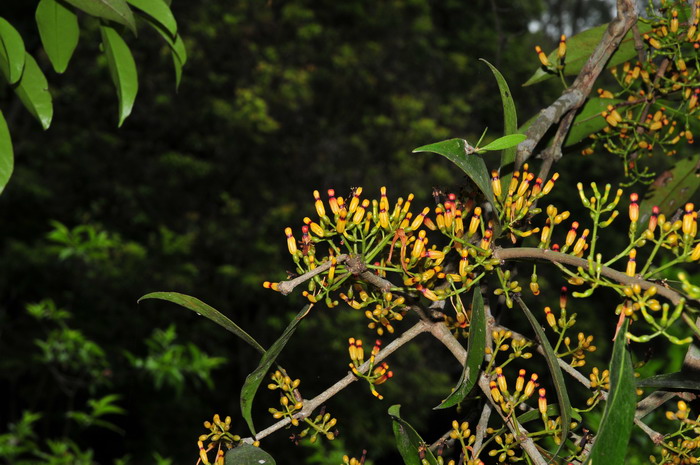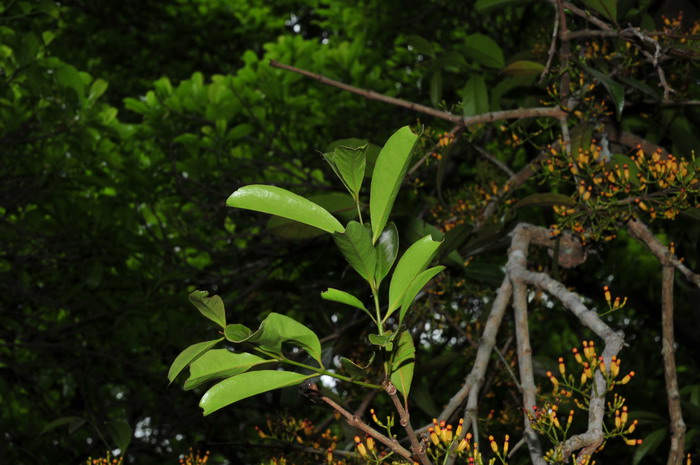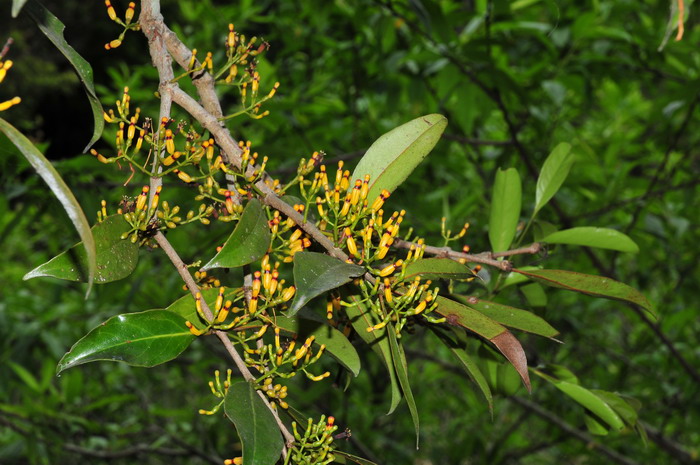鞘花Macrosolen cochinchinensis
中文名(Chinese Name):鞘花
学名(Scientific Name):Macrosolen cochinchinensis (Lour.) Van Tiegh.
英文名(English Common Name):杉寄生、狭叶鞘花
别名(Chinese Common Name):
异名(Synonym):Elytranthe cochinchinensis (Lour.) G. Don Elytranthe fordii (Hance) Merr. Elytranthe ampullacea var. tonkinensis Lecomte Elytranthe ampullacea (Roxb.) G. Don Loranthus ampullaceus Roxb. Loranthus cochinchinensis Lour. Loranthus fordii Hance Macrosolen fordii (Hance) Danser Elytranthe cochinchinensis var. tonkinensis (Lecomte) H. L. Li Tristerix viridiflorus Mart.
科属(Family & Genus):桑寄生科(Loranthaceae)鞘花属
形态特征(Description):灌木,高0.5-1.3米,全株无毛;小枝灰色,具皮孔。叶革质,阔椭圆形至披针形,有时卵形,长5-10厘米,宽2.5-6厘米,顶端急尖或渐尖,基部楔形或阔楔形,中脉在上面扁平,在下面凸起,侧脉4-5对,在下面明显或两面均不明显;叶柄长0.5-1厘米。总状花序,1-3个腋生或生于小枝已落叶腋部,花序梗长1.5-2厘米,具花4-8朵;花梗长4-6毫米,苞片阔卵形,长1-2毫米,小苞片2枚,三角形,长1-1.5毫米,基部彼此合生,花托椭圆状,长2-2.5毫米;副萼环状,长约0.5毫米;花冠橙色,长1-1.5厘米,冠管膨胀,具六棱,裂片6枚,披针形,长约4毫米,反折;花丝长约2毫米,花药长1毫米;花柱线状,柱头头状。果近球形,长约8毫米,直径7毫米,橙色,果皮平滑。花期2-6月,果期5-8月。
分布(Distribution):产于西藏、云南、四川、贵州、广西、广东、福建,生海拔20-1600米平原或山地常绿阔叶林中,寄生于壳斗科、山茶科等多种植物上。东南亚等各国也有。
用途(Use):全株药用,广东、广西民间以寄生于杉树上的为佳品,称“杉寄生”,有清热、止咳等效。
引自植物志英文版:FOC Vol. 5 Page 221
Macrosolen cochinchinensis (Loureiro) Tieghem, Bull. Soc. Bot. France. 41: 122. 1894.
鞘花 qiao hua| Loranthaceae | Macrosolen
Loranthus cochinchinensis Loureiro, Fl. Cochinch. 1: 195. 1790; Elytranthe ampullacea (Roxburgh) G. Don; E. ampullacea var. tonkinensis Lecomte; E. cochinchinensis (Loureiro) G. Don; E. cochinchinensis var. tonkinensis (Lecomte) H. L. Li; E. fordii (Hance) Merrill; Loranthus ampullaceus Roxburgh; L. fordii Hance; Macrosolen fordii (Hance) Danser.
Shrub 0.5-1.3 m tall. Branches grayish, scattered lenticellate. Petiole 5-10 mm; leaf blade broadly elliptic or ovate to lanceolate, 5-10 × 2.5-6 cm, leathery, lateral veins 4 or 5 pairs, abaxially prominent or obscure on both faces, base cuneate to broadly cuneate, apex acute to acuminate. Inflorescences solitary or 2- or 3-fascicled, axillary, sometimes at older leafless nodes, (2-)4-8-flowered racemes; peduncle 15-20 mm; bracts broadly ovate, 1-2 mm; bracteoles triangular, connate at base, 1-1.5 mm. Pedicel 4-6 mm. Calyx ellipsoid, 2-2.5 mm, limb annular; ca. 0.5 mm. Mature bud 1-1.5 cm. Corolla orange, straight, inflated in middle, 6-angled, lobes lanceolate, ca. 4 mm, reflexed. Filaments ca. 2 mm; anthers ca. 1 mm. Berry orange, subglobose, ca. 7 mm. Fl. Feb-Jun, fr. May-Aug.
Forests, plains, valleys, mountain slopes; ?100-1600 m. Fujian, Guangdong, Guangxi, Guizhou, Hainan, S Hunan, Sichuan, Xizang (Mêdog), Yunnan [Bhutan, Cambodia, India, Indonesia, Malaysia, Myanmar, Nepal, New Guinea, Sikkim, Thailand, Vietnam].
The plants have medicinal uses. Recorded hosts include Castanea mollissima, Cinnamomum camphora, Cunninghamia lanceolata, Ficus lacor, Liquidambar formosana, Schima superba, and Vernicia montana. The inflorescence, usually with four or more flowers and with pedicels 4–6 mm, immediately distinguishes this very common species from others recorded from China, even in the absence of corollas.



(责任编辑:徐晔春)
学名(Scientific Name):Macrosolen cochinchinensis (Lour.) Van Tiegh.
英文名(English Common Name):杉寄生、狭叶鞘花
别名(Chinese Common Name):
异名(Synonym):Elytranthe cochinchinensis (Lour.) G. Don Elytranthe fordii (Hance) Merr. Elytranthe ampullacea var. tonkinensis Lecomte Elytranthe ampullacea (Roxb.) G. Don Loranthus ampullaceus Roxb. Loranthus cochinchinensis Lour. Loranthus fordii Hance Macrosolen fordii (Hance) Danser Elytranthe cochinchinensis var. tonkinensis (Lecomte) H. L. Li Tristerix viridiflorus Mart.
科属(Family & Genus):桑寄生科(Loranthaceae)鞘花属
形态特征(Description):灌木,高0.5-1.3米,全株无毛;小枝灰色,具皮孔。叶革质,阔椭圆形至披针形,有时卵形,长5-10厘米,宽2.5-6厘米,顶端急尖或渐尖,基部楔形或阔楔形,中脉在上面扁平,在下面凸起,侧脉4-5对,在下面明显或两面均不明显;叶柄长0.5-1厘米。总状花序,1-3个腋生或生于小枝已落叶腋部,花序梗长1.5-2厘米,具花4-8朵;花梗长4-6毫米,苞片阔卵形,长1-2毫米,小苞片2枚,三角形,长1-1.5毫米,基部彼此合生,花托椭圆状,长2-2.5毫米;副萼环状,长约0.5毫米;花冠橙色,长1-1.5厘米,冠管膨胀,具六棱,裂片6枚,披针形,长约4毫米,反折;花丝长约2毫米,花药长1毫米;花柱线状,柱头头状。果近球形,长约8毫米,直径7毫米,橙色,果皮平滑。花期2-6月,果期5-8月。
分布(Distribution):产于西藏、云南、四川、贵州、广西、广东、福建,生海拔20-1600米平原或山地常绿阔叶林中,寄生于壳斗科、山茶科等多种植物上。东南亚等各国也有。
用途(Use):全株药用,广东、广西民间以寄生于杉树上的为佳品,称“杉寄生”,有清热、止咳等效。
引自植物志英文版:FOC Vol. 5 Page 221
Macrosolen cochinchinensis (Loureiro) Tieghem, Bull. Soc. Bot. France. 41: 122. 1894.
鞘花 qiao hua| Loranthaceae | Macrosolen
Loranthus cochinchinensis Loureiro, Fl. Cochinch. 1: 195. 1790; Elytranthe ampullacea (Roxburgh) G. Don; E. ampullacea var. tonkinensis Lecomte; E. cochinchinensis (Loureiro) G. Don; E. cochinchinensis var. tonkinensis (Lecomte) H. L. Li; E. fordii (Hance) Merrill; Loranthus ampullaceus Roxburgh; L. fordii Hance; Macrosolen fordii (Hance) Danser.
Shrub 0.5-1.3 m tall. Branches grayish, scattered lenticellate. Petiole 5-10 mm; leaf blade broadly elliptic or ovate to lanceolate, 5-10 × 2.5-6 cm, leathery, lateral veins 4 or 5 pairs, abaxially prominent or obscure on both faces, base cuneate to broadly cuneate, apex acute to acuminate. Inflorescences solitary or 2- or 3-fascicled, axillary, sometimes at older leafless nodes, (2-)4-8-flowered racemes; peduncle 15-20 mm; bracts broadly ovate, 1-2 mm; bracteoles triangular, connate at base, 1-1.5 mm. Pedicel 4-6 mm. Calyx ellipsoid, 2-2.5 mm, limb annular; ca. 0.5 mm. Mature bud 1-1.5 cm. Corolla orange, straight, inflated in middle, 6-angled, lobes lanceolate, ca. 4 mm, reflexed. Filaments ca. 2 mm; anthers ca. 1 mm. Berry orange, subglobose, ca. 7 mm. Fl. Feb-Jun, fr. May-Aug.
Forests, plains, valleys, mountain slopes; ?100-1600 m. Fujian, Guangdong, Guangxi, Guizhou, Hainan, S Hunan, Sichuan, Xizang (Mêdog), Yunnan [Bhutan, Cambodia, India, Indonesia, Malaysia, Myanmar, Nepal, New Guinea, Sikkim, Thailand, Vietnam].
The plants have medicinal uses. Recorded hosts include Castanea mollissima, Cinnamomum camphora, Cunninghamia lanceolata, Ficus lacor, Liquidambar formosana, Schima superba, and Vernicia montana. The inflorescence, usually with four or more flowers and with pedicels 4–6 mm, immediately distinguishes this very common species from others recorded from China, even in the absence of corollas.
(责任编辑:徐晔春)
踩一下[0]

顶一下[0]